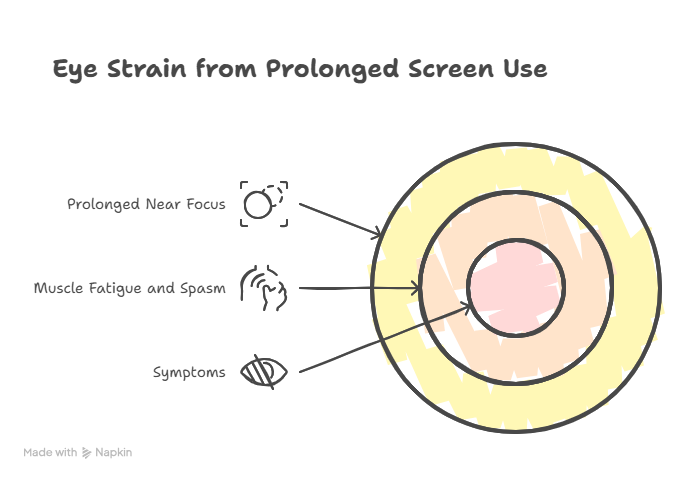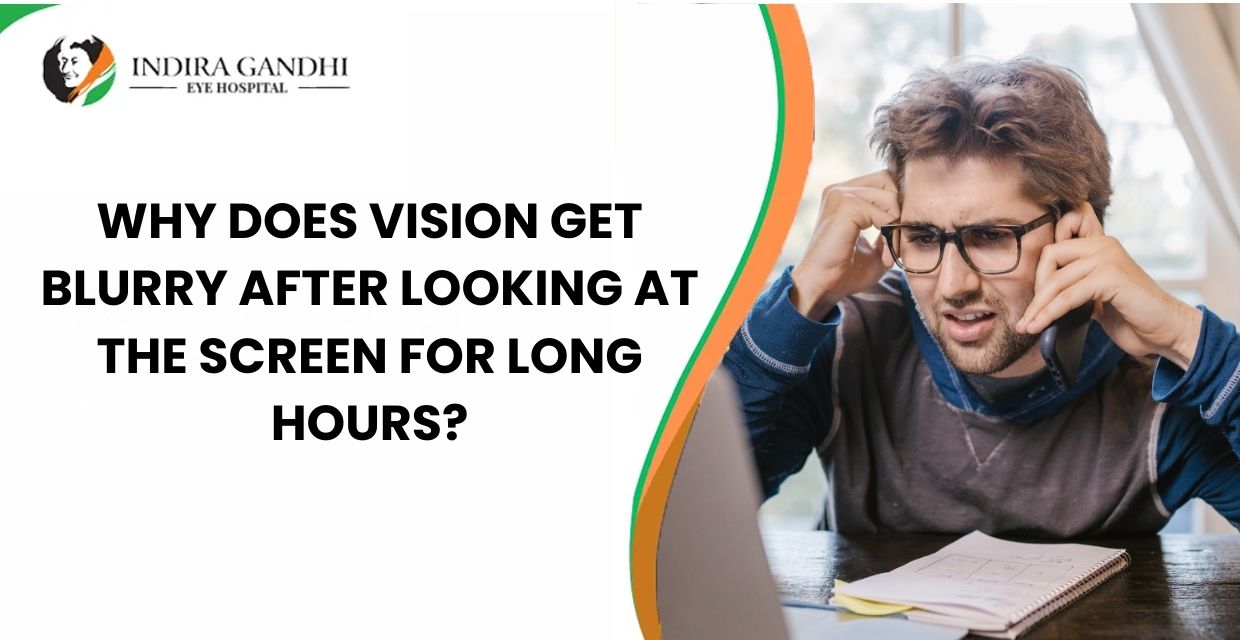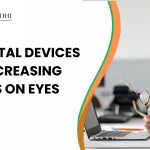|
Getting your Trinity Audio player ready...
|
In today’s hyper-connected world, it’s almost impossible to avoid screens. From the moment we wake up and check our phones to working on computers all day, unwinding with tablets, or enjoying movies on large screens, our eyes are constantly engaged with digital displays. If you’re like most people, you’ve probably experienced that familiar sensation: after hours of staring at your device, your vision starts to feel fuzzy, distant objects appear blurry, and your eyes might ache or feel incredibly tired.
You’re not alone in wondering, Why does vision get blurry after looking at the screen for long hours This common phenomenon is widely known as Digital Eye Strain, or sometimes Computer Vision Syndrome (CVS), and it’s a significant concern in our modern digital landscape. It’s not usually a sign of permanent eye damage, but it’s your eyes’ way of telling you they’re under stress and need a break. Understanding the underlying reasons for this blurriness and discomfort is the first step toward effective prevention and relief. Today, we’re going to dive deep into the fascinating mechanisms behind this widespread issue and equip you with practical strategies to protect your precious eyesight. At Indira Gandhi Eye Hospitals, we believe in empowering you with the knowledge to care for your eyes in this increasingly digital world.
The Modern Dilemma: Our Screen-Centric Lives
Consider the sheer amount of time we spend glued to screens. For many professionals, it’s 8 hours or more a day on a computer. Add to that the time spent on smartphones for communication and social media, tablets for reading, and smart TVs for entertainment. This constant near-work engagement is unprecedented in human history. Our eyes, while incredibly adaptable, were not designed for such prolonged, uninterrupted focus on illuminated, close-up digital displays.
The unique visual demands of screen use differ significantly from reading a physical book or looking at distant objects in nature. Screens present text and images composed of pixels, which may not be as sharply defined as print. They also involve contrast, glare, and flicker that can further strain the eyes. All these factors contribute to the widespread issue of digital eye strain, directly impacting why vision gets blurry after looking at the screen for long hours.
Experiencing blurry vision after long screen hours?
Digital Eye Strain is common, but it shouldn’t be ignored. Our eye specialists can help protect your eyes from screen damage and restore clear vision. Book your digital eye check-up today.
Book Digital Eye Check-UpDecoding the Blur: Why does vision get blurry after looking at the screen for long hours? The Mechanisms of Digital Eye Strain
The blurriness you experience after prolonged screen use isn’t due to a single cause but rather a combination of factors working in concert, placing unique demands on your visual system. Understanding these mechanisms is key to answering the question: “Why does vision get blurry after looking at the screen for long hours?”
1. The Silent Blinkers: Reduced Blink Rate and Dry Eye Syndrome
This is arguably the most significant contributor to why vision gets blurry after looking at the screen for long hours. When you’re intensely focused on a screen – whether it’s reading text, watching a video, or playing a game – your blink rate dramatically decreases.

- Normal Blinking: On average, people blink about 15-20 times per minute. Each blink serves a vital purpose: it spreads a fresh, healthy layer of tears across the surface of your eye, keeping it lubricated, clean, and providing essential oxygen to the cornea. The tear film, a complex three-layered structure (oil, water, mucus), is crucial for maintaining a smooth, clear refractive surface for light.
- Screen Staring: Studies have shown that when staring at a screen, our blink rate can drop by 50% to 70%, sometimes even more. This significantly reduced blinking leads to insufficient tear film renewal and increased evaporation of tears from the eye’s surface.
- Consequences: When the tear film evaporates too quickly or isn’t adequately replenished, the eye’s surface becomes dry. A dry, uneven tear film cannot properly refract light, leading to intermittent blurry vision, a gritty or burning sensation, redness, irritation, and discomfort. Your eyes try to compensate by tearing up excessively (reflex tearing), which provides temporary relief but doesn’t fix the underlying problem of an unstable tear film. This constant struggle for adequate lubrication directly answers why vision gets blurry after looking at the screen for long hours.
2. The Overworked Muscles: Accommodative Spasm and Fatigue
Your eye has an incredible ability to change its focus between near and distant objects. This process is called accommodation, and it’s primarily controlled by the ciliary muscle inside your eye, which changes the shape of your lens.

- Prolonged Near Focus: When you stare at a screen, your ciliary muscles remain in a state of sustained contraction to keep the image in focus. Unlike looking at a book, where your eyes might naturally drift or change focus subtly, screen use often demands an unyielding, fixed focus.
- Muscle Fatigue and Spasm: This constant contraction puts immense strain on the ciliary muscle. Over time, like any muscle under continuous stress, it can become fatigued. When it tires, it struggles to maintain clear focus, leading to blurriness. In some cases, the muscle can go into a “spasm,” where it temporarily locks into the near-focus position, making it difficult for your eyes to relax and refocus on distant objects when you look away from the screen. This temporary difficulty in shifting focus is often described as a temporary myopia or “pseudomyopia” (false nearsightedness).
- Symptoms: This accommodative fatigue or spasm manifests as blurry distance vision after long periods of near work, difficulty quickly shifting focus between near and far objects, and sometimes headaches, especially around the temples or forehead. This direct strain on your eye’s focusing mechanism is a major reason why vision gets blurry after looking at the screen for long hours.
3. The Eye Team’s Strain: Convergence Insufficiency and Fatigue
For your eyes to work together to see a single, clear image of a near object, they must turn inward slightly, a process called convergence.
- Sustained Convergence: Staring at a screen, especially one that is too close, requires your eyes to maintain a sustained inward turn. The extraocular muscles responsible for convergence are constantly working.
- Muscle Strain and Fatigue: Similar to the ciliary muscle, these convergence muscles can become fatigued from prolonged effort. When they tire, it becomes difficult for the eyes to maintain proper alignment.
- Consequences: This can lead to symptoms like eye strain, a feeling of “pulling” around the eyes, headaches (especially around the eyes), and sometimes temporary double vision or intermittent blur when the eyes struggle to converge properly. The effort required for your eyes to work as a coordinated team contributes significantly to why vision gets blurry after looking at the screen for long hours.
4. The Unseen Obstacles: Uncorrected Refractive Errors
Even if you don’t have a known vision problem, or if you have a very mild one that doesn’t bother you in daily life, any uncorrected refractive error (like a small amount of nearsightedness, farsightedness, or astigmatism) can be greatly magnified by prolonged screen use.
- Constant Compensation: If your eyes aren’t perfectly aligned to focus light onto your retina, your visual system has to constantly strain and compensate to achieve clarity. During short periods, this might be unnoticed. However, over long hours of demanding visual tasks on a screen, this continuous compensatory effort leads to significant fatigue and, ultimately, blurriness.
- Subtle Errors Matter: Even a slight, uncorrected astigmatism (irregularity in the cornea’s shape) can cause persistent blur and eye strain when viewing digital text composed of pixels. Having the precise prescription for computer use, which might be different from your everyday glasses, can alleviate this. This fundamental aspect of how your eye handles light plays a crucial role in why vision gets blurry after looking at the screen for long hours.
Experiencing blurry vision after long screen hours?
Digital Eye Strain is common, but it shouldn’t be ignored. Our eye specialists can help protect your eyes from screen damage and restore clear vision. Book your digital eye check-up today.
Book Digital Eye Check-Up5. The Glare & Contrast Game: Environmental Factors
The visual environment in which you use your screen also plays a significant role.
- Glare: Reflections from light sources (windows, overhead lights) on your screen, or the brightness of the screen itself, can cause significant glare. Glare forces your eyes to work harder to perceive the image, leading to fatigue and blurry vision.
- Poor Contrast: If the contrast between the text and background on your screen is too low, or if the font size is too small, your eyes strain to differentiate characters, contributing to visual fatigue and blur.
- Symptoms: Eye strain, difficulty reading, reduced reading speed, and general visual discomfort are common.
6. The Ergonomic Faux Pas: Improper Viewing Distance and Posture
The physical setup of your workspace can significantly impact your eye comfort.
- Incorrect Distance: Holding a screen too close forces more convergence and accommodation effort, while holding it too far away can make text too small and cause squinting.
- Awkward Angles: Staring at a screen that’s too high or too low can strain neck and shoulder muscles, which can indirectly contribute to overall tension that manifests as headaches and eye discomfort.
- Impact: Poor ergonomics leads to overall physical and ocular fatigue, contributing to why vision gets blurry after looking at the screen for long hours.
7. Blue Light (Contextual Contribution, Not Direct Blur Cause):
While blue light from screens has garnered much attention, its primary contribution to immediate blurry vision is less direct than the factors above. Blue light can contribute to eye strain, glare, and more significantly, can disrupt the body’s natural sleep cycle (circadian rhythm) when viewed extensively, particularly at night. Sleep deprivation then compounds eye fatigue and overall well-being, indirectly worsening the symptoms of digital eye strain, including blur. While blue light filters may offer some comfort, they don’t address the primary mechanical reasons why vision gets blurry after looking at the screen for long hours.
Beyond the Blur: Other Symptoms of Digital Eye Strain
The blurriness is just one symptom of digital eye strain. Other common complaints include:
- Eye fatigue or tiredness
- Dryness, burning, or stinging sensation in the eyes
- Redness or irritation
- Headaches (often frontal or around the eyes)
- Neck and shoulder pain
- Occasional double vision
- Light sensitivity
- Difficulty concentrating
Experiencing blurry vision after long screen hours?
Digital Eye Strain is common, but it shouldn’t be ignored. Our eye specialists can help protect your eyes from screen damage and restore clear vision. Book your digital eye check-up today.
Book Digital Eye Check-UpProactive Solutions: Practical Tips to Prevent Blurry Vision and Digital Eye Strain
The good news is that preventing and alleviating “Why does vision get blurry after looking at the screen for long hours?” is largely within your control. Implementing these practical strategies can make a significant difference in your daily comfort and long-term eye health:
- Embrace the 20-20-20 Rule: This is a golden rule for screen users. Every 20 minutes, look at something 20 feet away for at least 20 seconds. This simple act allows your eye muscles to relax from prolonged near focus, reducing accommodative fatigue and spasm. Set a timer or use an app to remind you.
- Blink Frequently and Consciously: Make a conscious effort to blink fully and frequently, especially when focused on a screen. If your eyes feel dry, use over-the-counter preservative-free artificial tears to replenish your tear film. Keeping your eyes well-lubricated is paramount to preventing blur.
- Optimize Your Workspace Ergonomics:
- Screen Position: Position your screen approximately an arm’s length (20-28 inches or 50-70 cm) away from your eyes. The top of the screen should be at or slightly below eye level, so you’re looking slightly downward at the center of the screen.
- Lighting: Reduce overhead lighting to minimize screen glare. Position your screen to avoid reflections from windows or bright lights. Use indirect, soft ambient lighting. If reading from a physical document, use a dim task light pointed at the document, not at the screen.
- Screen Settings: Adjust your screen’s brightness to match the ambient lighting of your room. Avoid excessively bright or dim screens. Increase contrast for easier reading. Adjust font size to a comfortable level. Consider using “warm” color temperatures (yellowish hues) for screens, especially in the evenings, which can be less harsh on the eyes than “cool” (bluish) light.
- Anti-Glare Filter: If glare remains an issue, consider an anti-glare screen filter.
- Posture: Ensure your chair provides good back support. Keep your feet flat on the floor and your wrists in a neutral position. A good posture reduces overall body tension that can contribute to eye strain.
- Stay Hydrated and Nourished: Drinking plenty of water helps maintain overall bodily hydration, which includes tear production. A diet rich in omega-3 fatty acids (found in fish, flaxseeds) can also support a healthy tear film.
- Use a Humidifier: If you live or work in a very dry environment (e.g., air-conditioned offices), a humidifier can help maintain ambient moisture, reducing tear evaporation.
- Consider Specialty Eyewear:
- Computer Glasses: If you use bifocals or progressive lenses, your current prescription might not be optimal for the specific viewing distance of a computer screen. “Computer glasses” are designed with specific power for that intermediate distance, reducing strain.
- Anti-Reflective Coating: This coating on your eyeglasses can reduce glare from screens and other light sources, improving comfort and clarity.
- Blue Light Filtering Lenses: While their role in preventing direct blur is secondary, some people find blue light filters beneficial for reducing overall eye strain and improving sleep patterns, especially if working on screens at night.
- Regular Comprehensive Eye Exams: This is paramount. Ensure you have regular eye check-ups with an ophthalmologist. They can identify and correct any underlying refractive errors (even subtle ones), diagnose dry eye syndrome, and rule out any other eye conditions. They can also recommend specific glasses or lens coatings tailored for your screen use.
Experiencing blurry vision after long screen hours?
Digital Eye Strain is common, but it shouldn’t be ignored. Our eye specialists can help protect your eyes from screen damage and restore clear vision. Book your digital eye check-up today.
Book Digital Eye Check-UpWhen to Seek Professional Help
While “Why does vision get blurry after looking at the screen for long hours?” is a common and usually temporary issue, it’s important to know when to seek professional medical advice. If your blurry vision persists even after taking breaks from screens, is accompanied by severe eye pain, sudden vision changes, double vision that doesn’t resolve, or significant headaches, consult an ophthalmologist promptly. These could be signs of underlying conditions that require professional attention.
Your Vision, Our Priority: Expert Care at Indira Gandhi Eye Hospitals
Understanding Why does vision get blurry after looking at the screen for long hours? empowers you to take control of your eye comfort and health in our increasingly digital world. Digital eye strain is a modern challenge, but with simple, consistent preventive measures, you can significantly alleviate its symptoms and protect your vision for years to come.
At Indira Gandhi Eye Hospitals, our experienced ophthalmologists are well-versed in diagnosing and managing digital eye strain and all its related symptoms. We provide comprehensive eye examinations to assess your visual needs in the digital age, offer tailored advice on ergonomics and lifestyle adjustments, and can prescribe appropriate eyewear solutions to ensure your eyes remain comfortable and clear, no matter how much screen time your day demands. We are dedicated to helping you maintain optimal eye health in every aspect of your life.
For personalized advice, a thorough eye examination, or any concerns about your vision, we invite you to connect with us. Visit our website at https://indiragandhieyehospital.com/ to learn more and schedule an appointment. Let Indira Gandhi Eye Hospitals be your trusted partner in navigating the digital landscape with clear, comfortable vision.
Experiencing blurry vision after long screen hours?
Digital Eye Strain is common, but it shouldn’t be ignored. Our eye specialists can help protect your eyes from screen damage and restore clear vision. Book your digital eye check-up today.
Book Digital Eye Check-UpFrequently Asked Questions (FAQs)
Is the blurry vision I experience after looking at screens for long hours permanent?
No, the blurry vision from prolonged screen use, commonly known as digital eye strain, is typically temporary. It’s a sign of eye fatigue and resolves after taking a break from the screen and resting your eyes.
What is the primary reason my vision gets blurry after looking at the screen for long hours?
The primary reasons are a reduced blink rate leading to dry eyes and the strain on your eye’s focusing muscles (accommodation spasm/fatigue) from prolonged near work. These factors prevent the eye from maintaining a consistently clear image.
Does using a blue light filter on my screen prevent blurry vision?
While blue light filters may help with sleep patterns and potentially reduce some eye strain by altering screen color temperature, they do not directly prevent the main causes of blurry vision related to screen use, such as dry eyes or muscle fatigue. Their benefit is more about comfort and sleep quality.
How does the 20-20-20 rule help with digital eye strain?
The 20-20-20 rule helps by giving your eye muscles a much-needed break from constant near focus. Every 20 minutes, looking at something 20 feet away for 20 seconds allows your focusing muscles to relax, reducing fatigue and preventing temporary blurriness.
Can existing uncorrected vision problems make digital eye strain worse?
Yes, even minor uncorrected refractive errors like slight nearsightedness, farsightedness, or astigmatism can be significantly magnified during prolonged screen use, forcing your eyes to work much harder and leading to more severe digital eye strain and blurriness.
Should I get special glasses for computer use if I spend many hours on screens?
If you experience persistent digital eye strain, special computer glasses with a prescription optimized for the intermediate viewing distance of a screen can be very beneficial. These can alleviate strain that regular reading glasses or distance glasses might not address.












